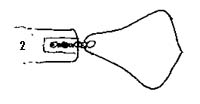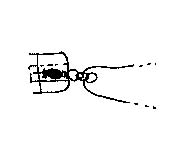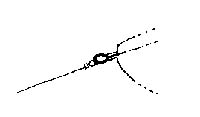


Necessary items
- Two treble hooks, Mustad roundbend bronzed size 2/0
- One Moore's lures style 8 flaptail body
- Two Bucher small splitrings
- One swivel of 16 mm long
- One splitring with a diameter of 6 mm
- One leader of single strand stainless steel wire with a diameter of 1 mm, 18 cm long
- One flaptail blade, nickel colored
- One cupwasher
- Two Countersunk washers
- One small nail without the head
- One Needle
- A hammer
- A pair of roundnose pliers
- Two component epoxy glue
Note: We start from a lureblank that has been painted and laquered.
The building process explained step by step
Drill three holes of 1,5 mm diameter for the three screw-eyes.
- The rear hook-hanger is positioned at 10,7 cm from the tip of the lure's nose.
- The front hook-hanger is positioned at 3,6 cm from the lure's nose.
- The line attachment-eye is positioned at 0,7 cm below the edge of the flat surface on the back of the lure.
Bend a single strand leader of 7" (18 cm) long from 1 mm stainless steel wire. Do not attach a swivel to the leader and attach one side to a screw-eye.

Make sure that both eyes are in one line, not bent opposed to eachtother.
 Now, attach the flaptail blade to the smal 6 mm diameter splitring and attach the splitring to the swivel. Take the needle and make a small hole in the side of the tail-end of the lure. The position of this small hole is shown by the dot on the stencil. It is located in the middle of the side of the lure and at 12 mm from the tail-end. It's necessary to puncture this hole first before pounding the small nail in it, because the wood might split. Now stick the nail through the hole. Push the swivel in to the pre-drilled hole in the tail-end and stick the nail through it's eye. Now take the hammer and gently tap the nail in the other side of the pre-drilled hole. Add a little epoxy glue to the nail before jamming it in the lureblank.
Now, attach the flaptail blade to the smal 6 mm diameter splitring and attach the splitring to the swivel. Take the needle and make a small hole in the side of the tail-end of the lure. The position of this small hole is shown by the dot on the stencil. It is located in the middle of the side of the lure and at 12 mm from the tail-end. It's necessary to puncture this hole first before pounding the small nail in it, because the wood might split. Now stick the nail through the hole. Push the swivel in to the pre-drilled hole in the tail-end and stick the nail through it's eye. Now take the hammer and gently tap the nail in the other side of the pre-drilled hole. Add a little epoxy glue to the nail before jamming it in the lureblank.

This is the result. The swivel is of course inside of the pre-drilled hole and only the splitring and one eye of the swivel sticks out of the hole.

The swivel is fixed in place by the nail.

Finally screw in the screw-eyes.
- The front screw gets a cupwasher inserted on the shaft to separate the eye of the screw-eye from the lureblank. It's positioned vertically as can be, as shown in the scetch.
- Both hook-hangers get a countersunk washer inserted on the shaft and they are fitted with a splitringed Mustad hook
Before screwing in the screw-eyes, smear a little epoxy glue on the shaft to secure them after they have been screwed in the pinewooden lureblank.
Finish off by sharpening the hooks.
It is the idea to attach your main line directly to the leader. Retrieve the faptail at a speed that is just enough to make the blade woggle from side to side like a spoon. If it spins, you are retrieving this lure way too fast!
Thight Lines! Dirk.




 Now, attach the flaptail blade to the smal 6 mm diameter splitring and attach the splitring to the swivel. Take the needle and make a small hole in the side of the tail-end of the lure. The position of this small hole is shown by the dot on the stencil. It is located in the middle of the side of the lure and at 12 mm from the tail-end. It's necessary to puncture this hole first before pounding the small nail in it, because the wood might split. Now stick the nail through the hole. Push the swivel in to the pre-drilled hole in the tail-end and stick the nail through it's eye. Now take the hammer and gently tap the nail in the other side of the pre-drilled hole. Add a little epoxy glue to the nail before jamming it in the lureblank.
Now, attach the flaptail blade to the smal 6 mm diameter splitring and attach the splitring to the swivel. Take the needle and make a small hole in the side of the tail-end of the lure. The position of this small hole is shown by the dot on the stencil. It is located in the middle of the side of the lure and at 12 mm from the tail-end. It's necessary to puncture this hole first before pounding the small nail in it, because the wood might split. Now stick the nail through the hole. Push the swivel in to the pre-drilled hole in the tail-end and stick the nail through it's eye. Now take the hammer and gently tap the nail in the other side of the pre-drilled hole. Add a little epoxy glue to the nail before jamming it in the lureblank.


